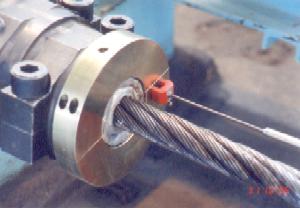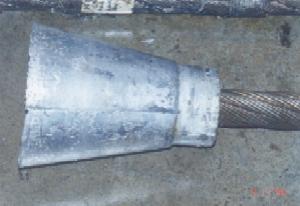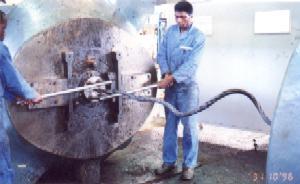| |
Downloads
THE TORSIONAL BEHAVIOUR OF
TRIANGULAR STRAND
STEEL WIRE ROPES FOR DRUM WINDERS
By: Gerhard Rebel
A thesis submitted to the
Faculty of
Engineering, University of the Witwatersrand,
in fulfillment of the requirements for the degree of Doctor of
Philosophy.
Johannesburg, 1997
|
|
ABSTRACT
|
The torsional behaviour of Lang’s lay triangular strand ropes will probably limit their
application in ultra deep (2500 m - 4000 m) single lift shafts. These ropes have
traditionally been used on the majority of South African drum winding systems and
it would be beneficial if their application could be extended as far as possible. An
improved understanding of the macroscopic factors which may lead to construction
instability is however required. The objective of this study has been the
determination and verification of a model to predict the static torsional behaviour
of triangular strand ropes operating on drum winders. Rope lay length changes at
installation; alterations in lay length with service period; rope rotation during
conveyance loading and equilibrium rope torques were the primary variables of
interest.
A wire rope tension-torsion testing machine has been developed for
conducting tests under constant twist, load and torque conditions. The relationship
between load and torque, for constant twists, is used to determine the in-service
lay length distributions.
It has been found that the lay length at which a rope is
manufactured significantly affects the in-shaft boundary conditions in the lay length
analysis. Correct lay length distributions values, in the suspended rope section, are
a prerequisite for the rotation calculations. The rotation analysis takes into account
changes in rope torsional stiffness resulting from the no-slip to slip transition,
between the rope wires, associated with twist displacements. This varying torsional
stiffness characteristic is a function of the rope load and state of twisting (lay
length). The hysteresis response during constant load tests, constitutes a first order
effect, but it has been ignored in previous attempts at calculating in-service rope
rotation. Consequently, far more rotations were forecast than is actually the case.
With the new model, rope lay length and rotation predictions compare favourably
with actual measured behaviour in existing shafts.
The results of in-service lay
length and rope rotation measurements, conducted in shafts up to 2500 m deep,
are also presented. Parameters which have the greatest influence on the torsional
behaviour of triangular strand ropes in vertical shafts have been identified and
recommendations are made on how the depth limit of application for these ropes
may be extended. |
|



Download 328 Page PDF Zip Archive (8381 kB) |

|
TORSIONAL
BEHAVIOUR OF WIRE ROPES FOR KOEPE WINDERS
By: Jason Minas Yiassoumis
A dissertation submitted to the
Faculty of Engineering, University of the Witwatersrand,
Johannesburg, in fulfilment of the requirements for the degree of
Master of Science in
Engineering, Johannesburg, 1992.
ABSTRACT
The torsional behaviour of steel wire ropes used on Koepe winders
for vertical shafts is analysed. Theoretical models have been
developed for the behaviour of both the head and tail ropes after
correcting an assumption made by previous researchers regarding the
torque in the ropes. The theoretical models utilise experimentally
obtained rope properties. The properties were measured from rope
samples tested in a laboratory using specially developed equipment
and software. Instruments were designed and used for in-situ
measurements on an 1800 m deep shaft during a complete return trip.
Some of the measurements were affected by unexpected strong
torsional oscillations. However the general trends of the measured
torsional behaviour were correctly predicted by the theoretical
models. Discrepancies are attributed to the difficulties of
obtaining true rope properties, to assumptions made in order to
obtain a workable model and to inaccuracies in the measured
behaviour because of the strong torsional oscillations. Further
research is recommended. Nevertheless there is sufficient
correlation between the models and the experiments, as well as with
other published results, to draw certain conclusions with
confidence. In particular the results confirm the adverse effect of
hoisting depth, the need to use non-spin ropes and the need for
swivels at both ends of freely looped tail ropes. New findings
include the importance of balanced frictional torque between the two
swivels of a tail rope and the realisation that the rope rotation is
caused by the torque difference between the two legs of a head or
tail rope and not the absolute value of the torques. The results
also emphasize the important role of the torsional stiffness of a
rope in relation to its torsional behaviour. The use of theoretical
models to design or select ropes suitable for specific Koepe winders
is suggested.
TORSIONAL BEHAVIOUR OF WIRE ROPES FOR KOEPE WINDERS (4706 kB)
TORSIONAL BEHAVIOUR OF WIRE ROPES FOR KOEPE WINDERS APPENDIX (1939
kB) |

|
|